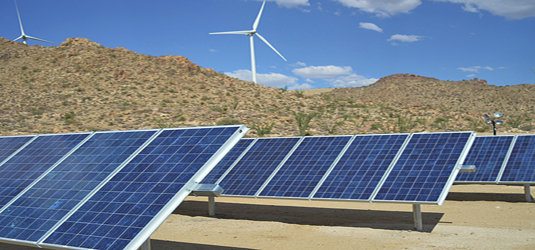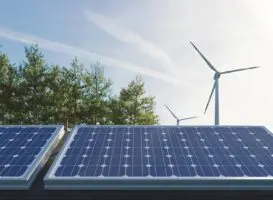
The International Energy Agency (IEA) has increased its mid-term renewable forecast by 13%. Largely on the back of key policy developments in the U.S., India, China and Mexico, the agency has pointed to wind and solar PV’s central role as increasingly “affordable solutions” in the fight against climate change and air pollution.
The IEA has been criticized in the past by sections of the solar industry for its conservative forecasts for PV deployment. There are signs that IEA may become more bold with its forecasting in the future, with the agency taking a more optimistic outlook on renewable deployment in its latest medium term forecast that predicts deployment between 2016 and 2021.
“2015 was indeed a record year for renewables,” said the Head of the IEA’s Renewable Division Paolo Frankl, when addressing media before the report’s release. Frankl noted that wind and solar PV were the leading renewable technologies in terms of growth and deployment in 2015, with 63 GW and 49 GW installed respectively, and that the year saw all renewables overtake coal in terms of cumulative installed capacity.
Key takeaways from the 2016 IEA MTMR
- IEA main case scenario sees 825 MW of renewable capacity added globally through 2021, up 13% on the IEA’s previous forecast.
- Policy and market improvements in the U.S. are responsible for 43% of the IEA’s upward capacity revision. Improvements in China, India and Mexico was the second most important factor for the increase
- 2015 saw 153 MW of renewables added globally, a record high.
- Emerging economies were responsible for 58% of the growth.
- China contributed 40% of global renewable additions.
- Asia is predicted to be a major driver of solar PV capacity expansion (see table).
Looking to the IEA’s forecasts, the medium term forecast for renewable deployment through to 2021 has been sharply increased. The key drivers for this increase is policy changes, Frankl explained that these are primarily the ITC extension in the U.S., state and federal developments in India, and the Chinese government’s rapid increase in renewable deployment.
Despite the increased prospects for solar and wind deployment in the U.S. in the latest IEA forecast, Asia will be responsible for more than 50% of renewable capacity growth in the medium term. “Asia is definitely in the lead,” said Frankl.
IEA solar PV cumulative capacity forecast key Asian markets
|
|
2015 (GW) |
2021 (GW) forecast |
|
India |
5.1 |
43.1 |
|
Japan |
34.1 |
60.6 |
|
Korea |
3.6 |
9.1 |
|
ASEAN |
2.5 |
8.6 |
|
China |
43 |
160 |
Specifically addressing the performance of solar PV, Frankl noted that “impressive progress” is being made by solar manufacturers in terms of cost reductions. He also pointed to BoS as being an area in which rapid progress on driving down costs is also occurring.
“[Solar PV] cost reductions will not stop anytime soon. Module prices will continue to go down because of the impressive progress in the manufacturing of panels,” said Frankl. The IEA’s renewables head pointed to the increasing scale of the solar manufacturing industry as one driver of cost reductions, but he also highlighted the industry’s openly communicated cost and energy intensity improvement roadmap and execution.
“[PV cost reductions are also due to] the improvement programs of the PV industry, that it is implementing in an incredibly consistent way,” said Frankl.
Turning to BoS and the deployment of PV, Frankl specifically addressed the as yet untapped potential of building integrated applications (BIPV). He noted that once PV modules and materials begin to be installed in buildings as a replacement for standard glass, that a further surge in reductions of installed costs would occur.
“There are all of the applications on buildings,” said Frankl. “A more systematic integration of PV in architecture has not even begun. When solar becomes standard in building design, there will be another dramatic reduction of costs.”
Policy counts
A key theme underpinning the IEA renewables report and Frankl’s commentary was the vital importance of policy settings to enable renewable deployment. “It is still dependent on policies, to create the right market rules and frameworks to attract investment,” said Frankl. “There is still a lot to be done here and too much uncertainty in many countries.”
In response to a pv magazine question about the reasons for the IEA previously being too conservative on forecasts, Frankl reiterated that it was changes in policy in key markets that resulted in the upward revision.
“This year we revised our forecast up by 13% as a result of recent policy enhancements, mainly in the U.S., China and India,” said Frankl. “The IEA has been signaling the policy uncertainty concerning the extension of tax incentives in the U.S. for years. In December 2015, the U.S. made a multi-year extension of the tax credits.”
Policy settings are also of crucial importance if battery storage is to be deployed at a sufficient scale, the IEA reports. While the 2016 medium term forecast does not address storage in any great detail, as variable renewable share increases, storage can be an important enabling technology. In his presentation to the press, Frankl specifically addressed how the business case for the cheapest present-day energy storage technology, pumped hydro, had in fact been damaged in his home market of Italy, as solar PV flattened peak electricity supply.
“In order to be economically viable, battery systems need to be able to combine multiple value stream, for example providing services for relieving grid congestion, combined with providing services to balance fluctuations in supply and demand,” said Frankl. “Often, the existing regulatory framework does not allow for such combinations – these things need to be fixed.”
The IEA forecasts battery uptake to occur in markets in which variable generation will only account for 10% of electricity generation by 2021, specifically the U.S., China and India.
The IEA will publish the latest version of its World Energy Outlook, in which a series of long term energy scenarios will be set out, on November 16.
Source: PV Magazine. Reproduced with permission.









